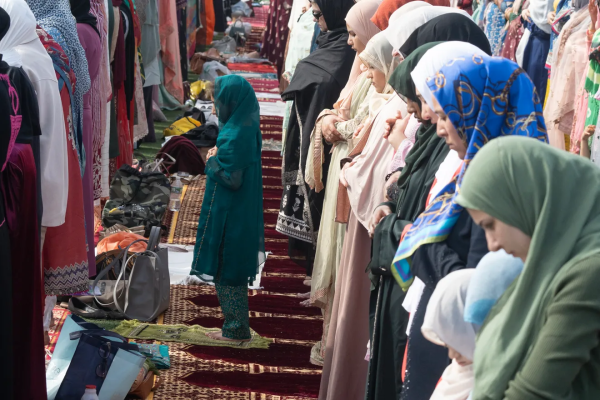Purim: The Story of One Person Changing the World
Anti-Semitism is just as prevalent today as it was over 2,000 years ago in the Persian Empire and over 80 years ago in Nazi Germany.
Hamantaschen are a traditional pastry for Purim that represent Haman’s hat. Two popular flavors, pictured here, are cherry and chocolate chip.
I guess you could say we like to party in the Jewish religion. It seems like there’s always a holiday. There’s celebrations of a New Year, miracles, freedom, trees, and, perhaps the most ironic of all, an almost-persecution.
The holiday where we celebrate an almost-persecution is better known as Purim. It’s one of my favorite holidays because I find the story behind it to be the most inspiring and relevant.
The Story
In the fourth century BCE, the Jews were subjects of the Persian Empire. King Ahasuerus ruled over the land from the capital of Shushan with his Prime Minister, Haman. During a drunken night of partying, the King called for his wife, Queen Vashti, to come and show off her beauty. She refused and was executed with the King’s order.
King Ahasuerus was now in search of a new queen, so he called for all of the beautiful women across the entire empire to come to the palace to participate in a beauty pageant. Esther—cousin of Mordechai, the leader of the Jewish people—was forcibly taken to the palace to compete in this pageant. King Ahasuerus fell in love with her the moment he saw her, and, despite what she wanted, made Esther the new Queen. Mordechai had one request of Esther: do not reveal your Jewish identity.
One day, Mordechai overheard two of the King’s servants discussing plans to assassinate him. Mordechai reported the traitors, and they were executed.
Meanwhile, Haman, the new Prime Minister, was forcing everyone to bow down to him through the King’s decree. He wore a gold idol around his neck, so Mordechai refused to bow down. (Worshipping idols is not a practice in the Jewish religion and is frowned upon.) This angered Haman, who was a descendant of the historically anti-Semitic nation of Amalek, and he decided he would get revenge by making a plan to kill all the Jews. When he presented this plan to King Ahasuerus, he agreed, and it was set that on the 13th of Adar (a month in the Hebrew calendar) all people would rise up and kill their Jewish neighbors.
When Mordechai learned of this decree, he knew he had to do something. He told Esther to go to the King and reveal her Jewish identity in a plea to save the Jews. How could she do this, though? There was a rule that no one could speak to the King unless he approached them, and Esther had not been summoned in almost 30 days. She worked up the courage and requested that Mordechai gather all the Jews in Shushan and fast for three days and three nights while praying. Esther would then risk her life, approach the King, and reveal her true self.
After the fast, Esther entered the King’s chambers and requested for him and Haman to join her at a small feast she prepared. Once the feast was over, she asked for them to join her in another feast the next day where she would make her official request. While Haman was leaving the feast, he passed by Mordechai, who once again refused to bow to him. Haman decided he would go to the King and request for Mordechai to be executed and began putting up the gallows.
That night when the King couldn’t sleep, he requested his servants tell him a story from the Royal Chronicles. They told him of how Mordechai saved his life, and the King immediately knew something had to be done for him. The next day, he asked Haman what he should do for someone who should be honored. Haman, assuming the King was speaking about him, said that he should dress them in a royal robe and have them paraded around Shushan on a royal horse. You can imagine Haman’s surprise and anger when the King told him to prepare this for Mordechai!
At the second feast, Esther told the king her and her people were sold to be persecuted by Haman. King Ahasuerus was outraged and ordered for Haman to be hung on the gallows he strung for Mordechai.
The King then promoted Mordechai to Prime Minister and issued a counter decree allowing the Jews to fight back against anyone who tried to hurt them. The battle went on for two days and on the 15th of Adar, the Jewish people celebrated their victory on what we now call Purim.
How Is It Relevant Today?
Anti-Semitism is known as one of the the oldest forms of bigotry. People have been trying to persecute the Jews for thousands upon thousands of years, as we see in the story of Purim.
I’ve seen numerous people say that anti-Semitism doesn’t exist in today’s world and say that it ended with the Holocaust, the most well-known large-scale act of anti-Semitism.
As unfortunate as it is, this is not true. Anti-Semitism is just as prevalent today as it was over 2,000 years ago in the Persian Empire and over 80 years ago in Nazi Germany. It didn’t disappear between those years, and it hasn’t disappeared since the Holocaust ended.
Recently I’ve noticed how sheltered I’ve grown up. I live in a community with a large Jewish population and thankfully can’t recall many times I’ve been a direct target of anti-Semitism. What I have seen, however, is numerous comments on social media platforms, especially Tik Tok.
Anti-Semitism is anti-Semitsim. It doesn’t matter if it’s a stereotypical comment made out of ignorance or an attempt to wipe the Jewish population from history.
Everytime I relearn about the story of Purim or see a comment that reads “Jews burn in Hell” on a Tik Tok, the only thing I can think is why? Why the Jewish people?
We are the scapegoats of history. Jews have been blamed for the death of Jesus, the Black Plague, the Great Depression, WWI, unrest in the Middle East, COVID-19, and even wildfires in California to name a few. Putting the blame on the Jewish people has allowed for anti-Semitism to grow to where it’s at today. It gives a foundation to keep building on and piling up the blame.
In 2019 and 2020, there were 11,026 incidents of anti-Semitsim in the United States alone. In 2021, the Anti-Defamation League has reported 52 incidents of anti-Semitism. It is only February.
These are just the ones that have been reported. These don’t include those Tik Tok comment sections that are flooded with “Hitler was right” and Swastikas.
Just last Saturday on NBC’s Saturday Night Live, Michael Che said, “Israel is reporting that they vaccinated half of their population, and I’m going to guess it’s the Jewish half.” This is an exact example of a “joke” that feeds into anti-Semitic tropes.
As a Jewish teenager, it’s terrifying to see how prevalent and almost normalized anti-Semitism is in today’s society. Every single comment I see just adds to this fear. Perhaps the scariest thing is how little activism there is from non-Jews. Practically everyone I see speaking up against anti-Semitsim is Jewish. It only takes one person to speak up, Jewish or non-Jewish.
What Can We Learn From Esther and Mordechai?
It only took one person to speak up and save the Jews from Haman 2,000 years ago. Esther did it with the support of Mordechai and the Jewish population.
Through Esther, we see a concrete example of how one person can make a difference. Anyone can do just what she did: speak up and speak out. I know it sounds cliche, but it really is true. Not everyone will make a difference as widespread as saving an entire population, but the difference you make will impact someone. An impact is an impact. It doesn’t matter if it’s saving thousands of lives or making one person’s day a little brighter.
Mordechai acts as a leader throughout the story. His compassion is what saved him. When he overheard that there were plans to kill King Ahasuerus, he decided to report them and save the King’s life. He did this even though the King had his own anti-Semitic traits and signed off on Haman’s plan. King Ahasuerus may have put a stop to Haman’s plan, but this was only after he found out Esther was Jewish. If Mordechai didn’t encourage and inspire Esther to speak up, the Jewish people wouldn’t have been saved from persecution.
When we celebrate Purim each year, we are reminded of the realities we see everyday. Anti-Semitism is real, and it will only go away once we all share the compassion Mordechai embodied.
We aren’t celebrating that someone almost killed the entire Jewish population; we’re celebrating the fact that we have survived time and time again. We are celebrating how one person can change the world with little compassion and encouragement.












